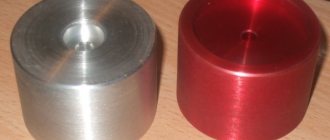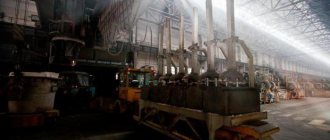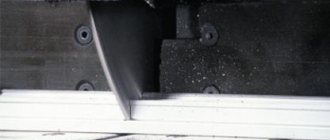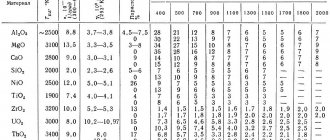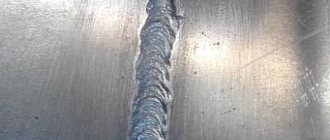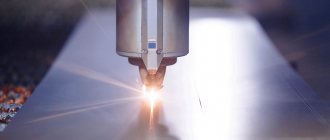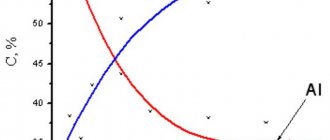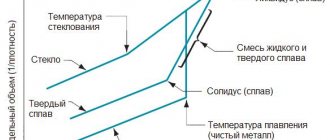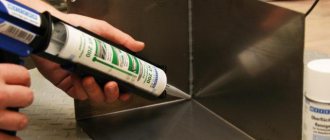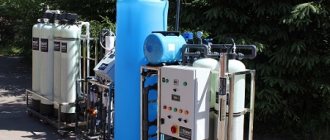Principles of the anodizing process
The process of electrochemical oxidation of aluminum and its alloys in solutions of sulfuric, chromic, oxalic acids and their mixtures is called aluminum anodization. Despite its apparent simplicity, the anodizing process has many options that directly affect the characteristics and quality of the oxide film. The appearance and structure of the coating is also affected by the composition of the aluminum alloy, and adjusting the electrolyte allows you to change the properties of the coating within a wide range. The quality and presence of impurities in the electrolyte composition can also be critical.
Anodizing differs significantly from the processes of electroplating metals (electrochemical deposition), in which a protective or decorative layer of metal is applied to the surface of a metal product, as it is a process of transforming the base metal, as a result of which the appearance and characteristics of the surface change.
Terms and concepts
First about terminology
For brevity, we will use “ anodic oxidation
" and "
anodic oxidation
" is a shorter, but with the same meaning, the term "
anodizing
", and instead of "GOST" "
anodic oxide coating
" - the simpler and more popular "
anodic coating
".
What is anodizing
Anodizing is a method of increasing the corrosion resistance of a metal product by forming a layer of oxide on its surface. The product being processed is the anode in this electrolytic process. Anodizing increases the product's surface resistance to corrosion and wear, and also provides greater adhesion to paints and adhesives than bare aluminum.
Anodic coatings can also be used as decorative coatings or as porous coatings that can absorb various dyes, or as transparent coatings that produce interference effects when light is reflected. Such interference coatings are used, for example, on bicycles or cyclists' clothing so that they can be clearly seen at night.
How does anodizing work?
The process of creating this protective oxide coating occurs electrolytically. The metal product to be coated with an anodic coating (usually aluminum) is immersed in a bath of electrolytic solution. Cathodes are installed in the same bath, usually along the sides of the bath. When an electric current passes through an acid solution, hydrogen is released at the cathode and oxygen at the anode. This leads to the fact that an oxide film begins to grow on the anode - the aluminum product.
Depending on the purpose of the anodic coating and the anodizing process used, it is possible to obtain an anodic coating with different characteristics. The anodic coating that can grow on an aluminum product can be 100 times thicker than the oxide coating that forms naturally on aluminum.
Since the metal piece is the "anode" in this electrolytic process, the entire process is called "anodizing."
Anodizing of metals
Although anodic coatings can also be formed on various metals, including titanium, hafnium, zinc and magnesium, anodizing generally refers to the anodizing of aluminum and its alloys.
Why anodize aluminum?
Aluminum's popularity is largely due to its good natural corrosion resistance. It is achieved due to the high chemical affinity of aluminum for oxygen, that is, their great mutual tendency to react with each other to form aluminum oxide. This very thin oxide film instantly coats any fresh aluminum surface as soon as it comes into contact with air. However, in some cases it is necessary to have a higher degree of protection (corrosion or chemical), modify the appearance of the surface (color, texture, etc.) or create specified physical properties of the surface (increased hardness, wear resistance or adhesion). In such cases, they resort to anodizing aluminum and aluminum alloys.
Figure 1 – Scheme of the anodizing process
Application of Anodizing
The use of anodization is a topic for a separate article; in any industry where products made of aluminum or its alloys are used to one degree or another and any properties of the metal need to be changed, anodization is the optimal and often the only solution.
Here is a list of the main areas of application of anodizing:
- Thin oxide films are used as a basis for applying organic and inorganic coatings (paint or varnish).
- Color anodizing. The use of various coloring electrolytes makes it possible to obtain a wide range of shades and colors of the surface of an aluminum product. Nickel, cobalt or tin salts are used as additives. The resulting shades range from light bronze to black.
- Increased wear resistance. Oxide coatings on aluminum are much harder than the base metal. Hard anodizing is widely used for parts subject to abrasion under light loads, as well as to increase the corrosion resistance of products.
- Electrical insulation. Compared to organic insulating materials, oxide film not only has high insulating properties, but also has significantly greater heat resistance.
- Obtaining a compacted surface with high anti-friction properties. (lubricating coating).
Aluminum
Anodized coating is done to improve corrosion resistance and prepare for painting. And also, depending on the technology used - either to increase roughness or to create a smooth surface. At the same time, anodizing in itself is not capable of significantly increasing the strength of products made from this metal. When aluminum comes into contact with air or any other gas containing oxygen, the metal naturally forms an oxide layer 2-3 nm thick on its surface, and on alloys its value reaches 5-15 nm.
The thickness of the anodized aluminum coating is 15-20 microns, that is, a difference of two orders of magnitude (1 micron is equal to 1000 nm). Moreover, this created layer is distributed in equal parts, relatively speaking, inside and outside the surface, that is, it increases the thickness of the part by ½ the size of the protective layer. Although anodizing produces a dense and uniform coating, microscopic cracks in the coating can lead to corrosion. In addition, the surface protective layer itself is subject to chemical decomposition due to exposure to an environment with high acidity levels. To combat this phenomenon, technologies are used that reduce the number of microcracks and introduce more stable chemical elements into the oxide composition.
Selecting anodizing electrolyte
As mentioned above, the properties of the oxide film obtained by anodization are influenced by many factors - the type of aluminum alloy, the method of pre-treatment of the surface of the part, the anodizing mode and the type of finishing operations. The composition of the electrolyte is also decisive. Acid electrolytes are mainly used (alkaline electrolytes can be used in some cases for special types of anodizing). The main acid is sulfuric; the vast majority of anodizing electrolytes are prepared on its basis. Other acids are used to obtain special types of coatings.
Invention
The first documented use of anodizing occurred in 1923 in England to protect seaplane parts from corrosion. Initially, chromic acid was used. Later, oxalic acid was used in Japan, but today in most cases, classic sulfuric acid is used in the electrolyte to create an anodized coating, which significantly reduces the cost of the process. Technology is constantly being improved and developed.
Anodizing in sulfuric acid electrolyte
Anodizing in sulfuric acid makes it possible to obtain translucent, colorless coatings with a thickness of about 35 microns. If the anodizing process is preceded by a process of glossing the surface of the parts, the coatings obtain high decorative qualities (shiny anodizing). In sulfuric acid, plastic anodic films are also obtained, which are not destroyed when molding products.
Sulfuric acid concentration and electrolyte temperature
The concentration of sulfuric acid for anodizing in industrial conditions is taken in the range of 8-35% (by weight). In a concentrated solution, the anodic film becomes soft and porous, and the elasticity of the film is high. The classic concentration is 15% (by weight). The temperature during the anodizing process is set in the range from 180C to 250C. In most cases, a temperature of 200C is accepted. Using sulfuric acid, solid anodic films are also obtained; in this case, the anodizing process is carried out at low temperatures (from -5 to +5 0C).
Temperature control during the anodizing process is mandatory; the current density and the rate of film dissolution depend on the temperature, which in turn has a direct impact on the quality and characteristics of the coating. In order to avoid local overheating of the electrolyte solution, special mixing devices are used.
Voltage and current density
When anodizing in sulfuric acid, a standard rectifier with an output voltage of up to 24 volts is used. In standard mode, the current is 16 volts with a current density of 1.5 A/dm2. To obtain corrosion-resistant films of large thickness, the voltage and current are raised to 18 volts, and when processing aluminum-silicon alloys to 22 volts. In some cases, for example, when anodizing rolled material or wire, alternating current is used. The use of a reduced current density makes it possible to obtain thin, transparent oxide films that are superior in transparency to films of similar thickness obtained at standard current densities.
Process duration
The duration of the anodizing process depends on the required film thicknesses, as well as the current density used. For pure aluminum this ratio can be proposed as:
Film thickness, microns. = (Current density, a/dm2 X Time, min.)/3
The ratio is approximate, since the duration of the process may depend on the type of alloy and processing mode.
The working process
The technological process of anodizing differs from the processes of applying galvanic coatings primarily in that the dissipative ability of anodizing electrolytes is significantly higher than that of electrolytes used in the processes of chrome plating, copper plating, galvanizing or nickel plating of metal. Effective dispersive ability with active mixing makes it possible to obtain films of uniform thickness over the entire surface of the products, including the internal surfaces of holes and grooves.
Otherwise, the technological process of anodizing is similar to the processes of electrochemical coating - products are immersed in a preheated electrolyte on hangers or clamps, the parts do not come into contact with each other, the distance to the cathode must be at least 15 cm (for larger products, the values are higher). Then the solution is stirred and current is applied. Under normal conditions, the cathode area should be equal to the anode area, and the cathode cross-section should be sufficient to ensure the required current density.
At the end of the process, stop the current supply and immediately remove the products from the galvanic bath. The products are washed in running water and dried.
Preparatory process
To obtain a smooth surface, the workpiece must be polished at the preparation stage. Using a felt or other polishing wheel, scratches are removed and large pores are tightened. The absence of micro-irregularities reduces the likelihood of burnouts. The anodic film is not able to hide external defects.
Before anodizing aluminum, it is necessary to determine the dimensions of the parts to be processed. The resulting layer is 50 microns thick, so it will be impossible to screw a nut onto the treated thread. If the parts are connected using a fit, then do not forget that after anodizing the parts cannot be ground.
Carrying out anodizing at home
To carry out the process, containers are needed. Containers for anodizing must correspond to the dimensions of the parts, and be slightly larger. Therefore, they usually use several baths. The material of the containers is aluminum. But if the products are small, then plastic containers are suitable. Only aluminum sheets need to be laid on the bottom and along the walls. This is necessary to create a current of uniform density throughout the entire volume.
The electrolyte needs to be insulated from external heat. When heating it will have to be changed. To prevent heating, the outside of the container is covered with a layer of thermal insulation. It can be covered with polystyrene foam up to 50 mm thick or, placed in a box, the free space can be filled with polyurethane foam.
A sulfuric acid solution is prepared by diluting the electrolyte for car batteries with distilled water in proportions of one to one. By purchasing a canister with a capacity of 5 liters, you can get 10 liters of solution.
Mixing, when water is added to the acid, is accompanied by abundant heat, and it literally boils and splashes. Therefore, for safety reasons, sulfuric acid is poured into a container of water.
Before anodizing aluminum begins, it is subjected to chemical preparation. Chemical preparation is a degreasing process. In industrial conditions, treatment is carried out with caustic soda or potassium. But at home it is better to use laundry soap. A toothbrush and soap solution can easily remove dirt from the surface. After that, the workpieces are first washed with warm water, and then with cold water.
An alternative to laundry soap is washing powder. After dissolving it in a closed plastic container and placing the parts to be processed there, shake vigorously. Then the parts are washed and dried with a stream of hot air. The active oxygen contained in the washing powder protects fat-free products, even if handled with bare hands.
Anodizing in chromic acid
Chromic acid is used if it is necessary to anodize critical aluminum parts and assemblies with thin walls or with high processing precision. The dissolution of aluminum in chromic acid is lower than in sulfuric acid, the reduction in the fatigue strength of the metal is lower - the film turns out to be thin, opaque gray in color. The maximum thickness of the oxide film reaches 10 microns, the standard thickness is from 2.5 to 5 microns.
The concentration of chromic anhydride CrO3 is taken in the range from 2 to 15% (by weight). In most cases, the regime temperature is set within the range of 25-400C; active stirring of the electrolyte solution is not required. When anodizing in a 10% solution of chromic acid, the process temperature is raised to 540C at a voltage of 30 volts to ensure a current density of 1.2 A/dm2. For alloys containing copper or zinc, the voltage is set within 15-20 volts at the same current density. When anodizing in an electrolyte of low concentration 3-5% (by mass), a special voltage supply mode is used and the process proceeds in cycles. This mode is used to detect defects in the surface of a product or when forming a sublayer for painting.
Cold technology
To anodize aluminum you need:
- power supply 12 V (battery, stabilizer);
- aluminum wires;
- rheostat;
- ammeter;
- containers for solutions.
Cold technology is different in that the growth of the anodized coating on the metal side proceeds at a faster rate than its dissolution on the outside.
First, the preparatory work described above is carried out. Then the parts need to be secured. It should not be forgotten that a film does not form under the fastening element. And suspended workpieces, when lowered into the container, should not touch the walls and bottom.
The anode is connected to the parts from the power source, and the cathode is connected to the capacitance. The current density is selected within the range of 1.6-4 A/dm2. Recommended values 2-2.2 A/dm2. At small values, the process will proceed more slowly, and at large values, a breakdown of the circuit may occur and the coating will begin to collapse.
It is not recommended that the electrolyte temperature rise above 5°C. When anodizing, the electrolyte does not heat up evenly. It is warmer in the center than in the corners of the container, so constant stirring is necessary.
The duration of anodizing using the cold method is about half an hour for small elements. For large parts, the duration may be 60-90 minutes. The end of the process is indicated by a changed color on the surface of the aluminum product. After disconnecting the wires, the part is washed.
Anodization in oxalic acid
In a solution of oxalic acid, yellow films with high wear resistance are obtained. This method is one of the first open methods for obtaining a colored coating. The wear resistance of the coating during abrasion is two times higher than when anodizing in sulfuric acid. In the process of anodization in oxalic acid, along with direct current with a voltage of 30-60 volts, alternating current modes are used. To obtain a uniform yellow or bronze tint, the solution is vigorously mixed. Otherwise, this process is no different from anodization in sulfuric acid. Various metals can be used as cathodes - iron, lead, stainless steel.
What is anodizing
The anodizing process is an electrolytic chemical reaction of a metal with an oxidizing agent. A thin layer of oxide is applied to a metal surface, which acts as an anode during the reaction. Due to polarization in an electrolytic conducting medium, both pure metals and various alloys can be coated with a thin oxide film. The oxide layer effectively protects against corrosion and fading when exposed to direct sunlight. The most in demand in industry are anodized alloys of aluminum and magnesium.
The ultimate goal of anodizing is to create a so-called AOP - anodic oxide film - on the surface of an aluminum sheet. It performs two main functions:
- Protection from external influences;
- Decoration.
In the second case, dyes of various colors with a strictly defined chemical composition are added to the conducting medium.
Engineers from the UK were the first to introduce industrial anodization of aluminum into production. The light and durable metal created in this way began to be used in the aviation industry. Later, a standard for metal anodization appeared, which is successfully used in modern aircraft construction. It has the nomenclature marking DEF STAN 03-24/3.
The coating consists of two components:
- organic;
- anode-chromium.
Paint applied in accordance with the standard is very resistant to abrasion and other mechanical damage.
Other anodizing solutions
In some cases, electrolytes are used in which the aluminum oxide film does not dissolve - so-called barrier-type electrolytes . Using anodizing solutions containing boric acid, ammonium tartrate, and ammonium borate, coatings are obtained on parts used in electrical appliances (electrolytic capacitors). For example, when treated in a solution with ammonium borate, films are obtained with a breakdown voltage of 550 volts. Also, these types of electrolytes are used in anodizing aluminum deposited in a vacuum.
Aluminum parts, the processing of which involves the application of galvanic coating after anodizing, are processed in a solution containing 25-30% phosphoric acid. The resulting films have a thickness of up to 6 microns, which is due to the high solubility of aluminum in phosphoric acid. The process is carried out at workshop temperature, current density 10-20 A/mm2 and voltage 30-60 volts for 10-15 minutes.
Solid films of golden, brown or black colors are obtained by using a solution containing 40-100 g/l sulfosalicylic acid and 30-60 g/l sulfuric acid at a temperature of 300C, a current density of 2.5-3.5 a/dm2 and a voltage of up to 80 volts.
Electrolyte preparation
Acid solutions are considered unsafe reagents, so to anodize aluminum at home, they resort to a different type of solution. To prepare it, use salt and soda, which you always have on hand.
To prepare the electrolyte, take two plastic containers. They are filled with salt and soda compositions, observing the proportion: per serving of salt or soda 9 servings of distilled water.
Anodizing at home
After dissolving the components, the solution is kept to allow undissolved particles to settle to the bottom. When pouring into a container for anodizing, it must be strained.
Removing anodic coatings
Poor-quality anodic coating can only be removed from the entire surface of the product; partial restoration of the film is impossible in most cases. The coating is usually removed in solutions containing caustic alkalis. The process takes place under strict control of the main modes, since such solutions have a high degree of impact on the base metal. The classic solution that has the least impact on the aluminum surface is one containing 35 ml/l phosphoric acid and 20 g/ml chromic acid. Treatment takes place within 1-10 minutes, depending on the thickness of the film at a temperature of 95-1000C. to remove hard anodic coatings, use the specified solution with a concentration twice as high, while the surface of aluminum alloys containing copper can be painted gray or black.
Re-processing of products after removing the anodic film is possible after assessing the condition of the surface of the product; if the surface cleanliness is sufficient for coating and polishing is not required, you can begin the process immediately.
It should be noted that when processing parts for which it is necessary to strictly adhere to the original dimensions, repeated anodization will be required with the application of a film of greater thickness than it was originally. This is because when the coating is removed and reapplied, losses can range from half to two-thirds of the original film thickness.
You may be interested in the following articles:
|
Types of anodizing
The QUALANOD organization divides aluminum anodizing into four main types with different requirements for their characteristics and properties:
- architectural (construction) anodizing
- decorative anodizing
- industrial anodizing
- hard anodizing.
Anodic coatings are divided into classes according to their thickness:
- minimum permissible average thickness and
- minimum permissible local thickness.
For example, class AA20 means that the average coating thickness must be at least 20 micrometers. The minimum local coating thickness should generally be at least 80% of the minimum average thickness. For class AA20 this is 16 microns.
Architectural anodizing
This is anodizing for the production of architectural finishing of products that are constantly exposed to outdoor conditions and in a stationary state. The most important characteristics of an anodized product are appearance and long service life.
For anodized aluminum, the degree of protection against pitting corrosion of aluminum increases with increasing thickness of the anodic coating. Consequently, the service life of architectural or building elements largely depends on the thickness of the anodic coating. However, obtaining a thicker anodic coating requires significantly more electrical energy. Therefore, so-called “re-anodizing” is not recommended.
Architectural anodizing has the following classes:
- AA10
- AA15
- AA20
- AA25
The choice of anodic coating thickness for external aluminum structures depends on the aggressiveness of the atmosphere and is usually specified in national regulations. In addition, the use of some colorants requires a thickness grade of 20 microns or higher. This is necessary to achieve good filling of the pores with the dye and increased resistance of the painted coating to sunlight.
Decorative
This type of aluminum anodizing is intended for the production of decorative finishing products. The main criterion for quality is a uniform or aesthetically pleasing appearance.
Decorative anodizing has the following standard thickness classes:
- AA03
- AA05
- AA10
- AA15
Industrial and solid
Industrial anodizing of aluminum is used to produce functional surface finishes for products when appearance is a secondary characteristic. The purpose of hard anodizing is to obtain a coating with high wear resistance or high microhardness.
Very often, for example in the automotive industry or medical equipment, the appearance of the product is not important, but the most important characteristic is resistance to wear and/or ability to be effectively cleaned and have high hygiene requirements. In such cases, it is these properties of anodized aluminum that are most important.
If the main property is high wear resistance, a special type of anodizing is used - hard anodizing. It is produced at low, often negative, electrolyte temperatures
Industrial and hard anodic coating thicknesses typically range from 15 to 150 microns. Threads and splines can be coated up to 25 microns. To obtain high electrical insulation, an anodic coating thickness of 15 to 80 µm is often required. Coatings with a thickness of 150 microns are used for repairing parts.
Special anodized aluminum films
In addition to high decorative qualities, anodized aluminum films have a number of very useful properties. For example, high hardness and wear resistance. The microcrystalline structure of corundum is practically not afraid of any abrasive. Sand and cement dust, and even metal carbides and silicides are not able to significantly damage the corundum protection.
Therefore, anodized parts cannot be cleaned with sandpaper or polishing or grinding paste. A thick layer of crystalline Al2O3 on the surface of rubbing parts increases the service life of any mechanism by two to three times. Protection made of oxidized aluminum is used for high-temperature painting of wheel rims, suspension elements of quarry machines and long-haul equipment.
Application of anodized aluminum coating:
- Does not degrade under the influence of frost, heat, ultraviolet radiation or chemically active substances, withstands direct contact with acids, alkalis, and organic solvents;
- Does not generate dust and does not wear out during repeated washing, cleaning, or under abrasive loads;
- There is no filamentary or gaseous form of corrosion; if the anodized aluminum layer is manufactured in compliance with the technology, then the service life of the coating can easily reach 60-80 years.
The second interesting quality of anodized aluminum film is low thermal conductivity. The processed metal is used to make foundry molds for casting copper alloys, despite the fact that the temperature of aluminum is several hundred degrees lower than that of copper. A thin, just a couple of millimeters oxidized coating reliably protects the aluminum mold from overheated liquid copper.
Heating radiators, pipeline fittings, boilers, stoves, fireplaces made of steel and cast iron are protected by anodized aluminum films according to modern standards. Even when walls, grates, and power fittings are heated to 500-600°C, steel and cast iron do not burn or corrode to rusty holes. The service life of a steel furnace has increased from 10 to 40 years of service.
Cold anodizing
Technologically, the process is similar to the previous option, the only difference is that such anodization occurs at a low temperature, in the range from -10 to +10 °C. The advantage of this method is that the protective film is thick and durable. The cold environment acts so that the layer grows faster on the inside than it dissolves on the outside.
The processed product is highly resistant to corrosion. The technique has a drawback - it is almost impossible to qualitatively paint anodized metal with organic compounds.
Painting improves the quality and aesthetics of the surface Source gidpokraske.ru
Application
Processed materials are used very widely. For example, in aviation, many structural elements contain aluminum alloys under study, and the situation is the same in shipbuilding. The dielectric properties of anodized coating predetermined its use in electrical products. Products made from processed material can be found in various household appliances, including players, flashlights, cameras, and smartphones. In everyday life, anodized iron coating is used, or rather, its soles, which significantly improves its consumer properties. When cooking, you can use special Teflon coatings to prevent food from burning. Usually such kitchen utensils are quite expensive. However, an uncoated, anodized aluminum frying pan can provide a solution to the same problem. At the same time, with less money spent. In construction, anodized profiles are used for installation of windows and other needs. In addition, multi-colored parts attract the attention of designers and artists, and they are used in various cultural and art objects around the world, as well as in the manufacture of jewelry.
Aluminum anodizing methods
The most common anodizing method is chemical oxidation, when a film is deposited on the surface of aluminum using a special electrolyte. Acid-based solutions are used:
- chrome;
- sulfosalicylic;
- sulfur;
- sorrel
In addition to chemical anodization, anodization can be integral, microarc, interference, and color oxidation is also used. By adding dye, you can get any color of the film, for example black.
Warm anodizing
This method of anodizing aluminum is used when the product needs to be painted afterwards. The film has a porous structure, which is a positive point for the adhesion of the coating with epoxy dye. A serious disadvantage can be considered the lack of mechanical and corrosion strength. Active metals and sea water can easily destroy the coating. This anodizing method can be used at home.
There is no clearly established temperature at which the conditions for the formation of crystalline oxide are created using the warm method of aluminum anodization. It is known that it should take place in a room where the temperature is comfortable for the body or it is increased, but not more than 50 °C. The process takes place in an electrolyte solution under the influence of voltage.
The previously degreased and washed part undergoes anodization until visually the entire treated surface becomes milky white.
Cold technology
Cold anodizing involves the same process of creating a crystalline oxide as with warm technology, but the solution temperature should not exceed 5 °C. A feature of the method is the accelerated growth of the anodic coating on the aluminum side relative to its dissolution on the electrolyte side.
What happens during cold anodizing:
- The container is filled with electrolyte.
- The part is lowered into the electrolyte, suspended, and connected to the anode.
- The cathode plate is also immersed in the solution and a constant voltage of 12 V is applied with a current density of 4–1.6 A/dm².
- When coating small products, wait 30 minutes, large ones - 60 minutes, after which the voltage is removed from the electrodes.
The advantage of the cold method: a high-strength oxide film is obtained that is resistant to any type of impact. Disadvantage: poor adhesion to dyes.
Electrolytes for integral color anodizing
These electrolytes include a wide range of organic acid solutions, usually with small additions of sulfuric acid. The resulting oxide coatings have double the wear resistance compared to conventional sulfuric acid coatings. The spectrum of colors ranges from pale gold to bronze and then to black. These processes are widely used in the production of building products such as windows, store entrances and building facades. Integral anodic coatings are very resistant to discoloration, which distinguishes them favorably from adsorption colored anodic coatings.
Sources: 1. TALAT 5203 2. QUALANOD Specifications, edition 01/01/2015
Practical Applications of Anodized Aluminum
Traditionally, the anodizing process is used to produce several types of oxidized films:
- Ultra-thin microcrystalline coatings with a thickness of 20-25 microns;
- Decorative films made of anodized aluminum;
- Electrical insulation based on crystalline Al2O3;
- Special protective films 1.5-2.0 mm thick.
Aluminum polished to a mirror reflects up to 98% of the light flux, but within a day, due to oxidation, a plaque forms, which turns into a gray film. Most optical instruments equipped with polished aluminum reflectors are protected by an ultra-thin microcrystalline film of colorless corundum. The dense, non-porous structure reliably blocks the access of oxygen and water vapor to easily oxidized aluminum, while maintaining 95-97% light transmission. Anodized aluminum film protects 99% of all headlights, high-power flashlights, reflectors and optical devices.
